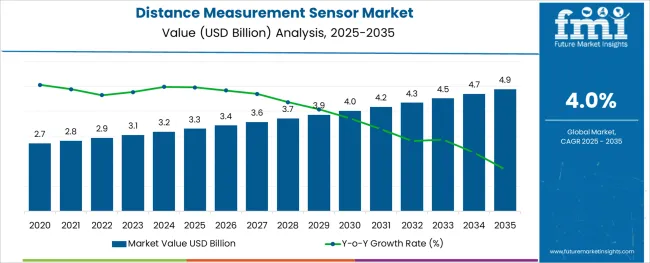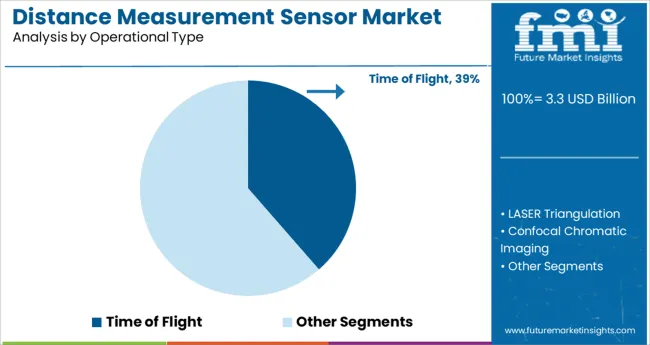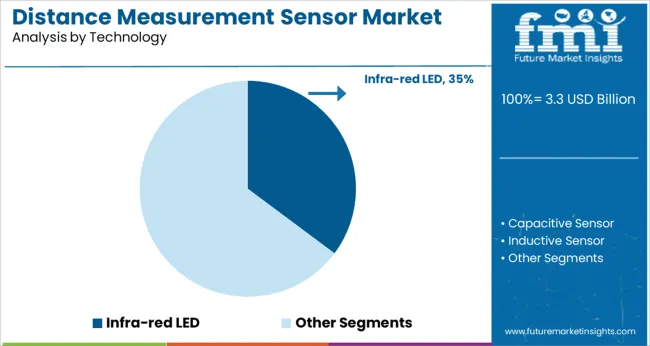The Distance Measurement Sensor Market is estimated to be valued at USD 3.3 billion in 2025 and is projected to reach USD 4.9 billion by 2035, registering a compound annual growth rate (CAGR) of 4.0% over the forecast period.

The distance measurement sensor market is experiencing notable growth driven by increasing demand for precision automation, robotics, and smart device integration across industrial and consumer applications. Advancements in sensor accuracy, miniaturization, and compatibility with embedded systems are accelerating adoption across sectors such as automotive, manufacturing, and consumer electronics.
The emphasis on safety, real time monitoring, and intelligent navigation has made distance sensing critical to autonomous technologies and quality assurance systems. Additionally, rising investments in smart infrastructure, Industry 4.0, and IoT ecosystems are expanding the deployment of sensors that offer reliable distance and proximity data.
The future trajectory of the market remains optimistic as innovation in optical and laser based technologies continues to enhance sensing efficiency while enabling energy efficient and scalable solutions for a wide range of applications.
The market is segmented by Operational Type, Technology, and Application Type and region. By Operational Type, the market is divided into Time of Flight, LASER Triangulation, Confocal Chromatic Imaging, Photoelectric Sensor, Retro-reflective, Diffuse Reflection Sensing, and Beam Sensing. In terms of Technology, the market is classified into Infra-red LED, Capacitive Sensor, Inductive Sensor, Ultrasonic, Laser Diode, Photo Electric, Draw Wire, Image Sensor, and Others. Based on Application Type, the market is segmented into Manufacturing, Robotics, Defense Aerospace & Intelligence, Automatic Identification, Packaging, Consumer Electronics, Automobiles, and Others. Regionally, the market is classified into North America, Latin America, Western Europe, Eastern Europe, Balkan & Baltic Countries, Russia & Belarus, Central Asia, East Asia, South Asia & Pacific, and the Middle East & Africa.

The time of flight segment is anticipated to account for 38.60% of the total revenue in 2025 under the operational type category, making it the dominant segment. This prominence is due to its ability to provide fast and highly accurate distance measurements across varying environmental conditions.
Time of flight sensors are widely preferred in automation, robotics, and augmented reality systems due to their superior response time and depth mapping capabilities. Their compact form factor and low power consumption make them well suited for integration into mobile devices and industrial automation platforms.
As the need for reliable three dimensional sensing grows across logistics, automotive, and security systems, time of flight sensors are expected to maintain their lead owing to their efficiency and adaptability.

The infra red LED segment is projected to contribute 35.20% of the overall market revenue in 2025 under the technology category, establishing it as the leading technology type. Its dominance is attributed to its cost effectiveness, reliability, and energy efficiency in short to medium range applications.
Infra red LED based sensors are extensively used in consumer electronics, gesture recognition, and indoor navigation systems. They offer consistent performance under various lighting conditions and are easy to integrate into compact and mobile devices.
The technology’s broad compatibility with control systems and minimal calibration requirements further support its widespread deployment. As demand increases for touchless user interfaces and energy efficient sensing solutions, the infra red LED segment continues to lead the market through its balance of affordability and technical performance.
Currently, market players provide a plethora of distance measurement sensors that combine several distinct technologies, including ultrasonic, optical, capacitive, inductive, and many more. Sensors are chosen depending on the application, the need for accuracy, cost, size, operating distance, and lifespan. Manufacturers provide proximity sensors and laser distance sensors that are utilized for short-distance measurement applications and long-distance measurement applications, respectively.
Global manufacturers provide dual-mode laser measurement sensors, which are deployed in a wide range of industrial applications for distance measurement. These sensors not only measure distance but can also detect changes in light intensity, enabling the parent system to pick up clear or translucent objects that traditional ones would have missed. Additionally, IO-link communication interfaces with bidirectional data transmission are also being added to distance measurement sensors by manufacturers.
For last some years distance measurement sensors have been integrated in the automobile vehicle like Cars, trucks, buses in order to provide the information of the surrounding of the vehicle to the driver which increases the safety factor and hence it is coming out as a new trend for distance measurement sensor market.
The key growth drivers of global distance measurement sensor market are increased adoption of distance measurement sensors in automation and robotics, need for advanced security solutions in the automobiles, drastic rising demand of distance measurement sensor in construction industries to trace the distance in various applications, increased demand in military application for target detection as in drone and aircrafts are some other drivers support the growth of this market.
On the other hand high sensitivity towards environmental factors affects its accuracy, as the accuracy of ultrasonic sensors reduces in high noisy environment & accuracy of proximity sensor decreases in brighter environment.

The key players of global distance measurement sensor market are Honeywell International Inc., Eaton, Balluf Inc., Baumer & others.
The report is a compilation of first-hand information, qualitative and quantitative assessment by industry analysts, inputs from industry experts and industry participants across the value chain. The report provides in-depth analysis of parent market trends, macro-economic indicators and governing factors along with market attractiveness as per segments. The report also maps the qualitative impact of various market factors on market segments and geographies.
The global distance measurement sensor market is estimated to be valued at USD 3.3 billion in 2025.
It is projected to reach USD 4.9 billion by 2035.
The market is expected to grow at a 4.0% CAGR between 2025 and 2035.
The key product types are time of flight, laser triangulation, confocal chromatic imaging, photoelectric sensor, retro-reflective, diffuse reflection sensing and beam sensing.
infra-red led segment is expected to dominate with a 35.2% industry share in 2025.






Full Research Suite comprises of:
Market outlook & trends analysis
Interviews & case studies
Strategic recommendations
Vendor profiles & capabilities analysis
5-year forecasts
8 regions and 60+ country-level data splits
Market segment data splits
12 months of continuous data updates
DELIVERED AS:
PDF EXCEL ONLINE
Distance Measurement Image Sensor Market Size and Share Forecast Outlook 2025 to 2035
Distance Health Technologies Market is segmented by Product, Application and End User
Laser Distance Meter Market
Measurement Technology in Downstream Processing Market Size and Share Forecast Outlook 2025 to 2035
Laser Measurement Integrating Sphere Market Size and Share Forecast Outlook 2025 to 2035
Wound Measurement Devices Market
Height Measurement Devices Market Size and Share Forecast Outlook 2025 to 2035
Phasor Measurement Unit Market Size and Share Forecast Outlook 2025 to 2035
Surface Measurement Equipment And Tools Market
Test and Measurement Equipment Market Size and Share Forecast Outlook 2025 to 2035
Body Fat Measurement Market Analysis - Trends, Growth & Forecast 2025 to 2035
Test and Measurement Sensors Market Size and Share Forecast Outlook 2025 to 2035
Sound Level Measurement Meter Market Size and Share Forecast Outlook 2025 to 2035
Respiratory Measurement Devices Market Size and Share Forecast Outlook 2025 to 2035
Digital Wound Measurement Devices Market is segmented by Diabetic Ulcer, Chronic Wounds, Burns from 2025 to 2035
Track Geometry Measurement System Market Size and Share Forecast Outlook 2025 to 2035
Coating Thickness Measurement Instruments Market
Cooling Laser Power Measurement Sphere Market Size and Share Forecast Outlook 2025 to 2035
Impedance-based TEER Measurement System Market Size and Share Forecast Outlook 2025 to 2035
Communication Test and Measurement Market Size and Share Forecast Outlook 2025 to 2035

Thank you!
You will receive an email from our Business Development Manager. Please be sure to check your SPAM/JUNK folder too.
Chat With
MaRIA